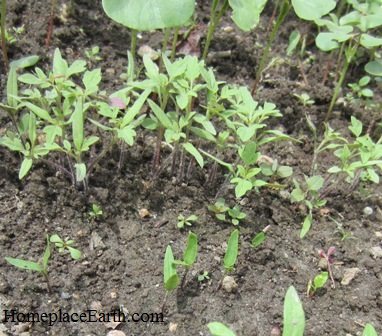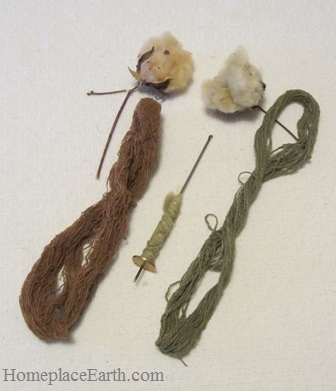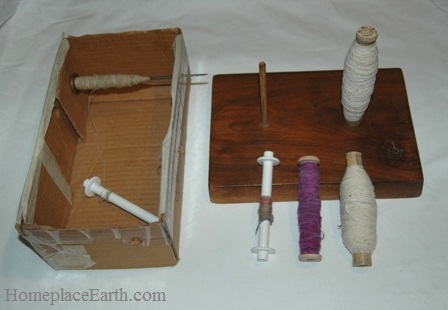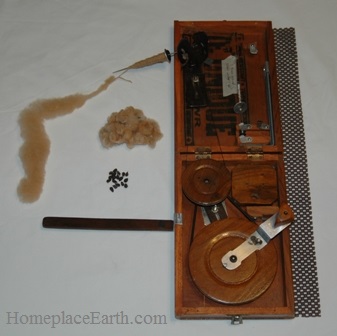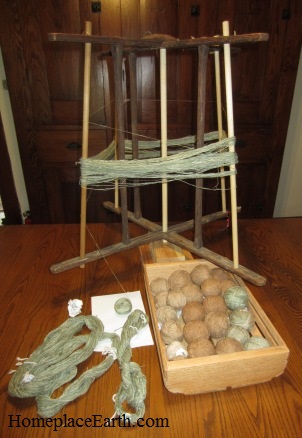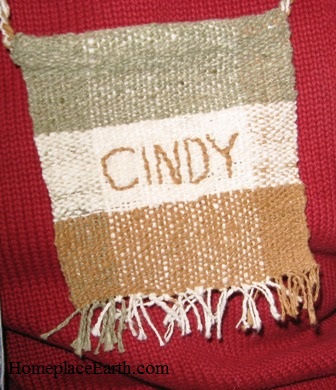 I took a serious interest in growing cotton and learning to spin it in 2011. I had grown a few cotton plants at a time before, but that year I planted an 80 square foot bed of Nankeen Brown and 22 square feet of Erlene’s Green. The cotton beds were about 100 feet apart. My first weaving project, a nametag, used cotton from the 2011 harvest and in the photo you can see the brown and green I grew. The white was from cotton I grew in the late 1990s. I cropped this image of the nametag from a photo taken by Mary Delicate, while I was wearing it at a VABF conference. A nametag might seem like an unlikely first weaving project, but I made it to wear at my spinning group meetings and have had fun with it elsewhere. It has come in handy to document those early colors. Although my records show the brown variety was Nankeen, that has been called into question recently since, apparently, Nankeen Brown has fuzzy seeds and my brown has naked seeds. Learn more about that at Seed Conundrum.
I took a serious interest in growing cotton and learning to spin it in 2011. I had grown a few cotton plants at a time before, but that year I planted an 80 square foot bed of Nankeen Brown and 22 square feet of Erlene’s Green. The cotton beds were about 100 feet apart. My first weaving project, a nametag, used cotton from the 2011 harvest and in the photo you can see the brown and green I grew. The white was from cotton I grew in the late 1990s. I cropped this image of the nametag from a photo taken by Mary Delicate, while I was wearing it at a VABF conference. A nametag might seem like an unlikely first weaving project, but I made it to wear at my spinning group meetings and have had fun with it elsewhere. It has come in handy to document those early colors. Although my records show the brown variety was Nankeen, that has been called into question recently since, apparently, Nankeen Brown has fuzzy seeds and my brown has naked seeds. Learn more about that at Seed Conundrum.
My cotton varieties were much closer than the recommended distance for avoiding cross pollination. The crossing was not reflected in the fiber that year from the parent plants, but held within the seeds. Some plants would have been pollinated by those of the same variety, but others would have been touched by pollen from the other variety. The plants that grew from those cross-pollinated seeds would be the F1 generation.
You have probably seen varieties designated as F1 in seed catalogs. That is always an indication that it is a hybrid. With hybrids, the parents are from different varieties of the same crop, and their offspring (F1 generation), although a mixture of genes with loads of potential, produce a predictable crop. Hybridization is done to produce the special qualities that can be found, and predicted, in that F1 generation. It is when you move beyond the F1 that things get exciting.
In 2012 I grew cotton from the 2011 harvest. The seeds for the green cotton were fuzzy and the seeds for the brown were naked. The green and brown colors of cotton that I grow are faint at harvest, deepening to their ultimate color once the skeins are scoured by boiling in soapy water after spinning. Since I was not aware of the extent of the crossing, I didn’t examine the fiber from each bed, considering everything from the green bed green and everything from the brown bed brown. I would have had to look closely to distinguish the difference in color within each bed when the fiber was all mixed together. In the photos, the color looks evident because it has already been sorted.
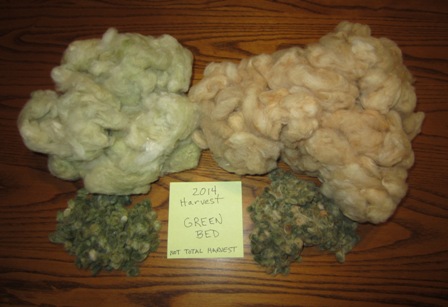
Part of the 2014 Green bed harvest.
I was spinning the cotton off the seed, so I didn’t see the seed until the fiber was already on my spindle. Examining the seeds helps determine differences. Once I scoured the spun yarn and the colors popped, I could see how much crossing had occurred. The vest I made in 2015 contained harvests from my 2012 and 2013 green cotton beds. It made for a wonderful pattern and made me think about what was happening with the seeds.

Part of the 2014 Brown bed harvest.
In 2014 I planted brown and green cotton seeds saved from the 2011 and 2012 harvests. In 2015 and 2016 I grew Red Foliated White cotton only. I decided to study my 2014 harvest by closely examining the seeds and fiber from the green and brown beds. The fiber from the green bed was either green or light brown and the seeds were all fuzzy. The fiber from the brown bed was brown or light brown, with the darker brown having naked seeds and the lighter brown having fuzzy seeds. It appeared that what had crossed expressed itself as light brown, whether in the green bed or the brown bed. Apparently, brown is the dominant color. The green cotton had a more silky feel than the brown and that showed up some in the light brown fiber. The feel of the fiber helped me separate the brown bed harvest. Next, I wanted to see what would happen if I grew out these four sets of seeds.
I enlisted the help of my daughter, Betsy, daughter-in-law, Stephanie, and friends Molly, Susan, and Margaret. Betsy had seeds from the brown bed with the dark brown fiber (B/B), Stephanie grew out seeds from the brown bed with the light brown fiber (B/b), Molly and Margaret grew out seeds from the green bed that produced green fiber (G/G) and Susan grew seeds from the green bed that produced light brown fiber (G/b). I asked them to grow out about 10-12 plants for me. Some grew more than that, and some grew less. None of them are spinners or have any other interest in cotton other than joining in the adventure with me. I have wonderful family and friends!
Most likely this was the F2 generation, but some could be F3. What Betsy grew, B/B, was uniformly dark brown fiber with naked seeds. Stephanie had light brown and dark brown fiber, all with fuzzy seeds. Surprisingly, she also had four bolls with white fiber! Although they just look dark and fuzzy now, the lint on the seeds of these white bolls definitely looked green at harvest.
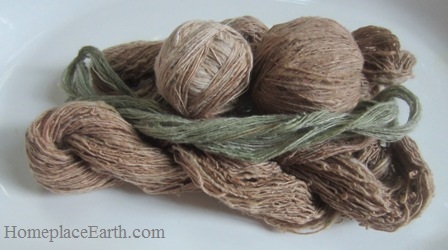
Harvest from Molly and Margaret (G/G). we were expecting mostly green fiber.
I thought that the plants with fiber that was definitely dark brown or green had not crossed. That was apparently so with Betsy’s harvest, but not so with Molly’s and Margaret’s (G/G). They had fewer plants, but nevertheless, I was expecting green and instead, got light brown to tan, with only a very small amount of green. Green is definitely recessive and elusive.
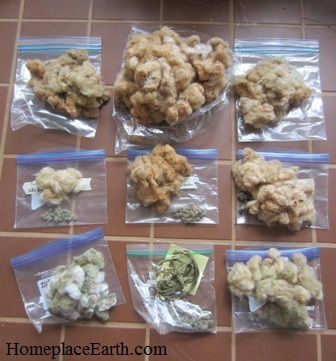
Susan’s harvest (G/b) was sorted into 9 colors/shades.
Susan (G/b) had a very interesting harvest with the most variation of green and brown and some of her colors were quite dark when scoured. Although most of her harvest had fuzzy seeds, she had some medium brown with naked seeds. I am sorting the colors of each harvest and spinning them separately, then scouring to find the true colors. In my garden this year I am growing the greens. I have pulled two from Susan’s harvest, the small bit from Molly and Margaret, and I will be including Erlene’s Green from Southern Exposure Seed Exchange. I’m looking forward to seeing what I will get, knowing full well they will be crossing with each other.
My wonderful crew is helping me again this year. Stephanie is growing out the white cotton. With green fuzzy seeds, we’re thinking she will get more than just white fiber. Molly and Margaret are each growing the light brown/tan fiber from their harvests. There should be green in there somewhere. Susan is growing seeds from the plants she grew that yielded silky brown fiber and had green fuzzy seeds. Betsy had to bow out of The Cotton Project this year because she is growing cotton for Southern Exposure. They asked her to grow Nankeen Brown, which is how we realized there was a question with naked vs. fuzzy seeds for that variety.
Sally Fox of Viriditas Farm has been researching colored cotton since the 1980’s and has been breeding for longer staple length and color. She says she has some F19 generations of cotton that haven’t settled yet and still yield surprises. We are having a good time with this and, from looking at Sally’s experience, it appears the adventure could continue for quite some time.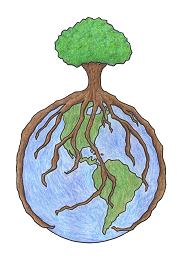
4/2/2021 edited to correct a date


